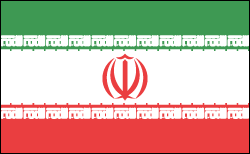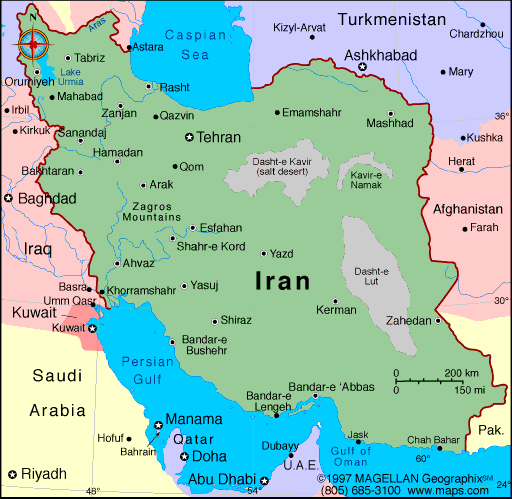IRAN

Geography: Iran, a Middle Eastern country south of the Caspian Sea and north of the Persian Gulf, is three times the size of Arizona. It shares borders with Iraq, Turkey, Azerbaijan, Turkmenistan, Armenia, Afghanistan, and Pakistan.
The Elburz Mountains in the north rise to 18,603 ft (5,670 m) at Mount Damavend. From northwest to southeast, the country is crossed by a desert 800 mi (1,287 km) long.
Government: Iran has been an Islamic theocracy since the Pahlavi monarchy was overthrown on Feb. 11, 1979.
History: The region now called Iran was occupied by the Medes and the Persians in the 1500s B.C. , until the Persian king Cyrus the Great overthrew the Medes and became ruler of the Achaemenid (Persian) Empire, which reached from the Indus to the Nile at its zenith in 525 B.C. Persia fell to Alexander in 331–330 B.C. and a succession of other rulers: the Seleucids (312–302 B.C. ), the Greek-speaking Parthians (247 B.C. – A.D. 226), the Sasanians (224–c. 640), and the Arab Muslims (in 641). By the mid-800s Persia had become an international scientific and cultural center. In the 12th century it was invaded by the Mongols. The Safavid dynasty (1501–1722), under whom the dominant religion became Shiite Islam, followed, and was then replaced by the Qajar dynasty (1794–1925).
During the Qajar dynasty, the Russians and the British fought for economic control of the area, and during World War I, Iran's neutrality did not stop it from becoming a battlefield for Russian and British troops. A coup in 1921 brought Reza Kahn to power. In 1925, he became shah and changed his name to Reza Shah Pahlavi. He subsequently did much to modernize the country and abolished all foreign extraterritorial rights.
The Elburz Mountains in the north rise to 18,603 ft (5,670 m) at Mount Damavend. From northwest to southeast, the country is crossed by a desert 800 mi (1,287 km) long.
Government: Iran has been an Islamic theocracy since the Pahlavi monarchy was overthrown on Feb. 11, 1979.
History: The region now called Iran was occupied by the Medes and the Persians in the 1500s B.C. , until the Persian king Cyrus the Great overthrew the Medes and became ruler of the Achaemenid (Persian) Empire, which reached from the Indus to the Nile at its zenith in 525 B.C. Persia fell to Alexander in 331–330 B.C. and a succession of other rulers: the Seleucids (312–302 B.C. ), the Greek-speaking Parthians (247 B.C. – A.D. 226), the Sasanians (224–c. 640), and the Arab Muslims (in 641). By the mid-800s Persia had become an international scientific and cultural center. In the 12th century it was invaded by the Mongols. The Safavid dynasty (1501–1722), under whom the dominant religion became Shiite Islam, followed, and was then replaced by the Qajar dynasty (1794–1925).
During the Qajar dynasty, the Russians and the British fought for economic control of the area, and during World War I, Iran's neutrality did not stop it from becoming a battlefield for Russian and British troops. A coup in 1921 brought Reza Kahn to power. In 1925, he became shah and changed his name to Reza Shah Pahlavi. He subsequently did much to modernize the country and abolished all foreign extraterritorial rights.

Map of Iran
Chief of State: Ayatollah Ali Khamenei
(1989)
President: Hassan Rouhani
(2013)
Land area: 631,659 sq mi (1,635,999 sq
km); total area: 636,293 sq mi (1,648,000 sq km)
Population (2014 est.): 80,840,713 (growth
rate: 1.22%); birth rate: 18.23/1000; infant mortality rate: 39/1000;
life expectancy: 70.89
Capital and largest city (2011 est.):
Tehran, 7.304 million
Other large cities: Mashhad 2.713 million; Esfahan 1.781 million; Karaj 1.635 million; Tabriz 1.509 million; Shiraz 1.321 million (2011)
Monetary unit: Rial
National
name: Jomhuri-ye Eslami-ye Iran
Languages:
Persian (official) 53%, Azeri Turkic and Turkic dialects
18%, Kurdish 10%, Gilaki and Mazandarani 7%, Luri 6%, Balochi 2%, Arabic
2%, other 2%
Ethnicity/race:
Persian 61%, Azeri 16%, Kurd 10%, Arab 2%, Lur 6%, Baloch 2%, Turkmen 2%, other
Religions:
Muslim (official) 99.4% (Shia 90-95%, Sunni 5-10%), other
(includes Zoroastrian, Jewish, and Christian) 0.3%, unspecified 0.4%
(2011 est.)
National Holiday:
Republic Day, April 1
Literacy rate: 85% (2008 est.)
Economic summary: GDP/PPP (2013 est.):
$987.1 billion; per capita $12,800. Real growth rate: -1.5%.
Inflation: 42.3%. Unemployment: 16%. Arable land:
10.05%. Agriculture: wheat, rice, other grains, sugar beets,
fruits, nuts, cotton; dairy products, wool; caviar. Labor force:
27.72 million; note: shortage of skilled labor; agriculture 16.9%,
industry 34.4%, services 48.7% (2012 est.). Industries: petroleum,
petrochemicals, textiles, cement and other construction materials,
food processing (particularly sugar refining and vegetable oil
production), metal fabrication, armaments. Natural resources:
petroleum, natural gas, coal, chromium, copper, iron ore, lead,
manganese, zinc, sulfur. Exports: $61.22 billion (2013
est.): petroleum 80%, chemical and petrochemical products, fruits and
nuts, carpets. Imports: $64.42 billion (2013 est.):
industrial raw materials and intermediate goods, capital goods,
foodstuffs and other consumer goods, technical services, military
supplies. Major trading partners: Japan, China, Italy, South
Korea, Turkey, Germany, UAE,
India (2012).
Communications: Telephones:
main lines in use: 28.76 million (2012); mobile cellular: 58.16
million (2012). Broadcast media: state-run
broadcast media with no private, independent broadcasters; Islamic
Republic of Iran Broadcasting (IRIB), the state-run TV broadcaster,
operates 5 nationwide channels, a news channel, about 30 provincial
channels, and several international channels; about 20 foreign
Persian-language TV stations broadcasting on satellite TV are capable of
being seen in Iran; satellite dishes are illegal and, while their use
had been tolerated, authorities began confiscating satellite dishes
following the unrest stemming from the 2009 presidential election; IRIB
operates 8 nationwide radio networks, a number of provincial stations,
and an external service; most major international broadcasters transmit
to Iran (2009). Internet hosts: 197,804 (2012).
Internet users: 8.214 million (2009).
Transportation: Railways: 8,442 km (2010).
Roadways: total: 198,866 km; paved: 160,366 km (including 1,948
km of expressways); unpaved: 38,500 km (2010). Waterways: 850
km (on Karun River and Lake Urmia) (2012). Ports and harbors:
Assaluyeh, Bushehr. Airports: 319 (2013).
International disputes:
Iran protests Afghanistan's limiting flow of dammed Helmand River
tributaries during drought; Iraq's lack of a maritime boundary with Iran
prompts jurisdiction disputes beyond the mouth of the Shatt al Arab in
the Persian Gulf; Iran and UAE dispute Tunb Islands and Abu Musa Island,
which are occupied by Iran; Azerbaijan, Kazakhstan, and Russia ratified
Caspian seabed delimitation treaties based on equidistance, while Iran
continues to insist on a one-fifth slice of the sea; Afghan and Iranian
commissioners have discussed boundary monument densification and
resurvey.
-------------------- o --------------------
No comments:
Post a Comment